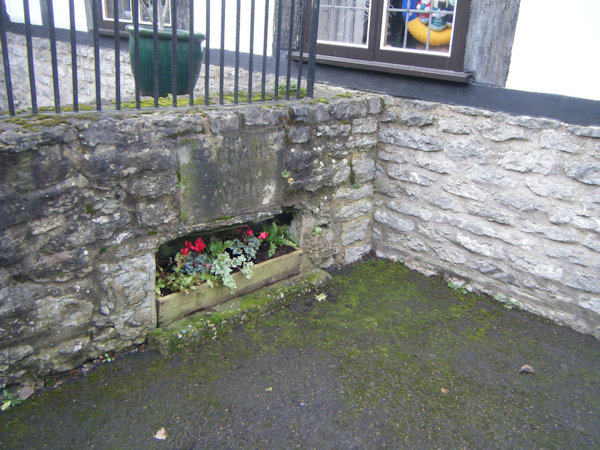 |
Dedication: Saint Owen Location: Much Wenlock Coordinates: 52.596430N, -2.558218W Grid reference: SO622999 Status: dry/destroyed Heritage designation: Grade II listed building |
HOME - ENGLAND - SHROPSHIRE
 |
Dedication: Saint Owen Location: Much Wenlock Coordinates: 52.596430N, -2.558218W Grid reference: SO622999 Status: dry/destroyed Heritage designation: Grade II listed building |
There has been some confusion over who exactly the patron saint of this well is. It is possible that the well is dedicated to the English St Owen, a saint from the 7th century who, after entering into the monastic life at St Cedd's monastery in Lastingham, Yorkshire, followed St Chad to Lichfield and became a monk there. It is possible that this Owen travelled to Much Wenlock at some point during his lifetime, but it is unlikely. It has also been suggested that the well's patron is the 7th century Frankish St Ouen, whose name is sometimes spelt "Owen"; he was the advisor of St Baldhild, who founded the convent at which St Milburga was likely educated, Seine-et-Marne. If the patron saint is him, then the well must have been established on the part of Milburga after her arrival in Much Wenlock. Alternatively, it has been theorised that Owen is some obscure Welsh saint of the 6th or 7th century, who spent time in Much Wenlock as a hermit. I could find no evidence to support this theory, but it is possible that "Owen" is a corruption of the name of the Welsh and Cornish martyr St Wen, which would fit with R.C. Hope's statement that the well is dedicated to a "Welsh saint", although Wen was active in the 5th century.
The origin of the name "Much Wenlock" has been much debated, and one of the theories about its etymology is that the name actually derives from a garbled form of "St Owen's Well". "Wen" is an Anglicised version of the originally Cornish name "Owen"; "lock", or "loch" (the name was recorded as "Wenloch" in the Domesday Book), which likely derives from, again, a Cornish word, means, just like the lochs of Scotland, some kind of water feature. Put together, the name "Wenlock" means "Owen's stream" or, more aptly, "Owen's Well". This would support the idea that the patron saint is the Cornish St Wen. The name "Wenlock" (though spelt slightly differently over the ages) has been used since at least the 9th century. Of course, this is only a theory, and "Wenlock" may be derived from another source.
During the medieval period, many pilgrims were attracted to Much Wenlock to see both the relics of St Milburga (who was very popular in the area) and the holy wells of the town. Much Wenlock's holy wells were in fact so popular with pilgrims that, at some point before the Reformation, an alabaster bath of some description was created in the middle of the cloisters of Wenlock Abbey; this bath was fed with water from both the well of St Milburga (presumably the one nearest the Abbey) and the well of St Owen, and pilgrims would bathe in it as part of their visit to the Abbey, in the hope of getting cured. It was presumably filled in after the Reformation, but it was discovered again in the late 19th century, as was recorded in Volume 5 of Transactions of the Shropshire Archaeological and Natural History Society, in 1882:
|
Since the above was written Mr. Gaskell, the owner of the Priory, has converted the Prior's House into a fine mansion for himself, preserving most judiciously the characteristic architectural features. The whole of the ruins have been excavated down to the original level, and a large octagonal sacristy has been discovered on the south side of the choir, as well as two sepulchral cross slabs, in the cloisters, and a beautiful alabaster sculptured basin or reservoir in the centre of the cloister, into which the water from the Holy Wells of St. Owen and St. Milburga was conveyed for the use of the numerous pilgrims who resorted there to be miraculously cured of disease. |
The earliest known reference to the well can be found in the parish register of Sir Thomas Botelar, who was the vicar of Much Wenlock's parish church during part of the 16th century. Botelar was the last abbot of the Benedictine Monastery of St Peter and St Paul, in Shrewsbury, before the institution's dissolution. St Owen's Well is mentioned several times in his register:
|
5 February 1542: Agnes Pyner was buried aged 120 and more she died in an house in Mardfold near St Owens well. 26 May 1546: Here was buryed out of the Strete called Mardfold out of the two Tenements nexte unto Sancte Owens Well on the same side of the well, the body of Sr Willm Corvehill Priest... 20 July 1550: Qo die in pulto legi p'ochis meis i't' divina sole'nia' Actu' p'liati Edwardi vjti de deciis debite & fidel'r solve'd. St Owens Well in Mardfold Street. |
The Victorian era saw the destruction of the gabled structure that once housed the well, and it was reduced to what it is now: nothing more than a flower bed. In fact, it appears that what is now an oddly shaped planter was once the top of a small opening or doorway that provided access to the well-house. Today, although the Grade II listed structure is evidently well cared for, the structure is unfortunately only a small remnant of what it once was.
 |
|
Access: The remains of the well are located at the side of a quiet road in Much Wenlock, and the site is easily accessible. |
Copyright 2025 britishholywells.co.uk